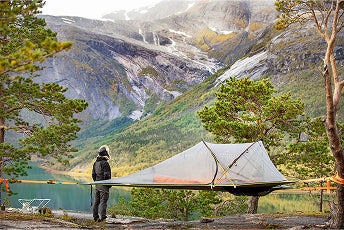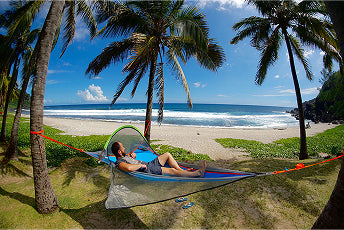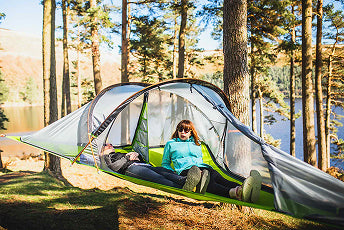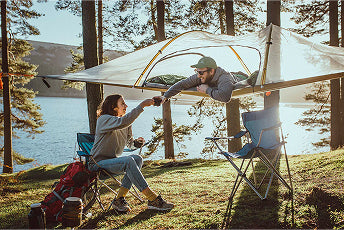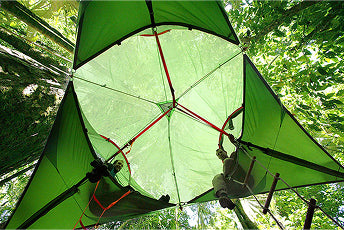Sometimes you just need to get away from it all. Spending time in nature and challenging yourself to a new adventure big or small can be hugely rewarding and help you to build your confidence in lots of ways and to spread your wings and venture out alone on solo expeditions. Not only that but it gives you space for self-reflection and time to destress away from the busyness of everyday life. If you are new to solo camping then you could start small with a micro adventure; one night away, perhaps not too far from home in an area you know. This will be good practice to plan for your trip and learn what items are handy to have in your pack and how to stay safe. Before you know it, you’ll be a seasoned solo camper and encouraging others to do the same.
In this guide:
- Planning a solo Camping Trip
- Packing for a solo camping trip
- Staying safe on a solo camping trip
- Setting up your tree tent
Planning a solo camping trip
Choosing the right site
There are some considerations to bear in mind when looking for your camping spot. If you are taking your Tentsile Tree Tent or Hammock then you will need an area with some strong healthy trees or sturdy posts or even your vehicle to use as your anchor points. Familiarise yourself with the area and make sure it’s somewhere you are going to feel safe. If there are bodies of water, is there any risk of flooding? Will it attract mosquitos and other unwanted visitors? If there are any cliff faces, are you out of the way of any potential falling rocks? You might also want to be close to a toilet area for night-time visits so you don’t have to go too far.
Checking the trees, coverage and ground
You can find lots of helpful resources and advice on our website but here are a selected few videos and guides to get you started. It’s best to camp over flat grassy soft ground where possible for safety and to make getting in and out of the tent easier. You are most likely to be off the ground anyway unless you have opted for the ground conversion kit.
Check out our video to help you select strong healthy trees to attach your tree tent to.
Read our Visual Assessment and Anchor Selection Guide.
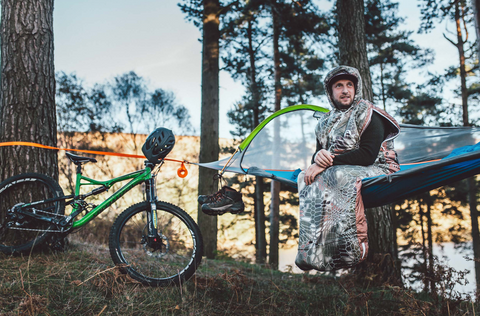
Avoiding privately-owned land and dangerous areas
Do some research into your final destination before you go especially if you are planning to wild camp. Things to look out for might be: are you allowed to camp there? Are there any site rules? Are there any dangerous animals to be aware of? Are there any cliff edges or marsh land to watch out for?
Check the weather
Be prepared for the weather, particularly if you are going somewhere that is likely to have changeable weather through the day and night. If it’s hot you will need to pack sun cream, extra tarps for shade and additional water or wind breaks and extra layers for cold and windy weather. A change of clothes, tarp for shelter and waterproofs are recommended for wet weather.
Buying the right tree tent and accessories
Your camping gear choices are really important when you are going solo. You’ll only have yourself to rely on and you’ll be carrying everything so if you are backpacking then you need to keep it light! The UNA is Tentsile’s 1-person lightweight tree tent perfect for the solo hiker and camper. It’s packed size is 35x15x16cm so it packs up into a small bag that won’t take up too much space or weigh you down at just under 2kg. You can use the UNA on its own but there are also several other options available in our store for additional set up options including the Sky-Pad air mattress to ensure you get a comfortable night’s sleep.
UNA Ground camping stack; includes UNA tree tent, Ground conversion kit, UNA double bubble insect mesh, Sky-Pad inflatable mattress, tent wall, pegs and pole
If you prefer a little extra room in your hammock tent then there are larger size options such as the lightweight Flite 2-person Tree Tent, or even roomier but weightier 2-person Connect Tree Tent (ideal if you are driving to your camping spot).
Navigation
GPS is a wonderful thing but if you really want to take things back to basics make sure you are armed with a map and a compass.
Nearby facilities
Check this out in advance. It will be useful to know whether there are any toilets available and whether you will have cell network in the area.
Safety
Feeling safe will no doubt enhance your enjoyment of the trip so have the above precautions in place and always let someone know where you are going.

Packing for a solo camping trip
You’ll need to make sure you have a suitable backpack that is comfortable to wear if you plan to do a lot of walking and consider the weight of the bag as you pack. Create a list so you can add items to it in the days leading up to your trip and it could be a list that you keep for future trips too.
Packing suggestions:
- Sleeping bag, pillow
- Camping mattress / sleeping pad
- Tarp
- Removable rainfly (this will give you options to change your set up depending on the weather)
- Bug net
- Appropriate clothing
- Lamp/torch and extra batteries
- Food and water
- First Aid Kit including sun protection and insect repellent
- Map/ GPS
Staying safe on a solo camping trip
Part of the appeal of solo camping is the unknown, setting challenges that might be out of our comfort zone and the solitude. However, safety is important and putting measures in place, and planning head to make sure that you feel safe will ultimately make your experience a lot more enjoyable.
Pay attention to your surroundings and study your route so you are familiar with your whereabouts. Don’t panic if you think you might be lost or find yourself in unexpected circumstances, remain calm, this will help you to think clearly and make smart decisions.
Be responsible and follow the leave no trace principles including proper fire safety and cause little or no disturbance to the immediate area around you by properly disposing of litter and keeping food off the ground so animals are not drawn to your camp. Be wary and respectful of wildlife – they were there first!
Follow the rules of the campsite if this is where you’re staying, they will be in place for a reason and will ensure that all campers get along in a neighbourly way.
Setting up your tree tent
It’s always worth practicing your set up at home or somewhere local before venturing out too far but if you can’t do that, read the instructions and watch any instructional videos available.
Here are some helpful videos for setting up your Tentsile on your own.
Set up for UNA 1-person Tree Tent
Pack down for UNA 1-person Tree Tent
Choosing three anchor points
Getting in and out
Above all, have fun! Make the most of being in nature, taking in the fresh air and scenery and come home with some stories to tell your friends!

